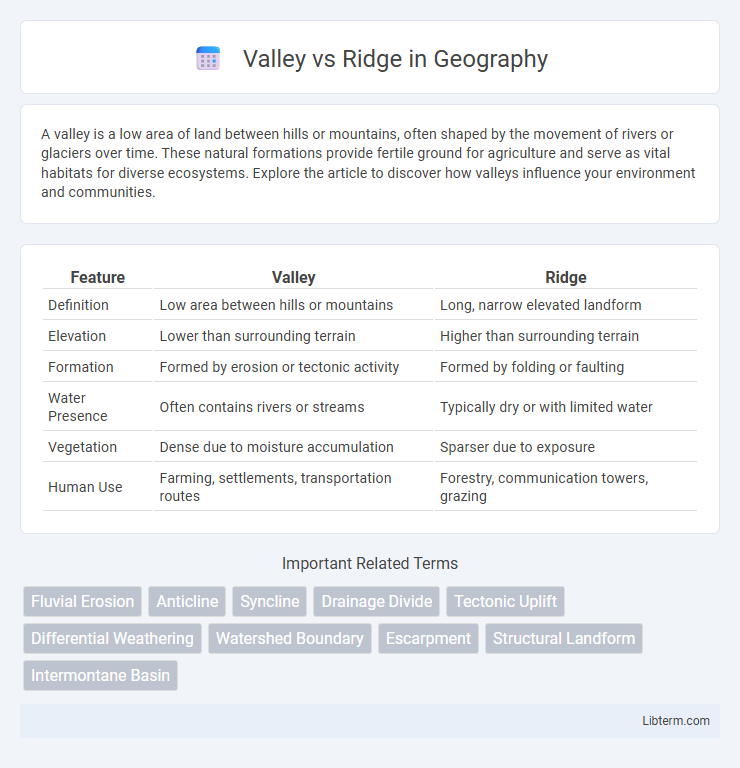A valley is a low area of land between hills or mountains, often shaped by the movement of rivers or glaciers over time. These natural formations provide fertile ground for agriculture and serve as vital habitats for diverse ecosystems. Explore the article to discover how valleys influence your environment and communities.
Table of Comparison
| Feature | Valley | Ridge |
|---|---|---|
| Definition | Low area between hills or mountains | Long, narrow elevated landform |
| Elevation | Lower than surrounding terrain | Higher than surrounding terrain |
| Formation | Formed by erosion or tectonic activity | Formed by folding or faulting |
| Water Presence | Often contains rivers or streams | Typically dry or with limited water |
| Vegetation | Dense due to moisture accumulation | Sparser due to exposure |
| Human Use | Farming, settlements, transportation routes | Forestry, communication towers, grazing |
Introduction to Valleys and Ridges
Valleys and ridges are fundamental landforms shaped by geological processes such as erosion and tectonic activity. Valleys are low-lying areas typically formed by river erosion, characterized by a distinct U- or V-shaped cross-section depending on their origin. Ridges, in contrast, are elevated landforms often created by resistant rock layers or tectonic uplift, forming narrow, elongated crests separating adjacent valleys.
Geographical Definitions: What is a Valley? What is a Ridge?
A valley is a low-lying landform typically situated between hills or mountains, characterized by a river or stream flowing along its floor, formed primarily through erosion or glacial activity. A ridge is a long, narrow elevated landform with a continuous crest, created by tectonic forces or erosion resistance, often serving as a natural divide between different watersheds. Both features are integral to landscape morphology, influencing drainage patterns, vegetation distribution, and human settlement.
Formation Processes: Erosion vs Uplift
Valleys primarily form through erosion, where water, ice, or wind gradually wears down the land, carving out depressions between higher areas. Ridges result mainly from uplift processes, where tectonic forces push rock layers upward, creating elongated elevated formations. The contrasting formation mechanisms highlight erosion as a subtractive force shaping valleys and uplift as a constructive force building ridges.
Visual and Structural Differences
Valleys are elongated low areas between hills or mountains, characterized by concave shapes that collect water and form rivers or streams, while ridges are elongated raised landforms with convex shapes that create natural divides. Visually, valleys often appear as green, lush corridors due to vegetation and water presence, whereas ridges display exposed rock or sparse vegetation due to elevation and wind exposure. Structurally, valleys result from erosional processes like river cutting or glacial activity, whereas ridges form through tectonic forces, folding, or resistant rock layers that withstand erosion.
Ecological Roles of Valleys and Ridges
Valleys serve as vital ecological corridors that facilitate wildlife movement and support diverse habitats by channeling water flow and nutrient distribution. Ridges, characterized by their elevation and exposure, often host specialized plant communities adapted to drier, windier conditions and act as natural barriers influencing microclimates and species distribution. The interplay between valleys and ridges creates varied environmental gradients essential for maintaining regional biodiversity and ecosystem resilience.
Human Settlement Patterns in Valleys vs. Ridges
Human settlements in valleys typically benefit from fertile soil, access to water sources, and milder climates, fostering agriculture and transportation. In contrast, ridge settlements often face challenges such as limited arable land and harsher weather but provide strategic advantages for defense and communication. The contrast in topography influences population density, economic activities, and infrastructure development patterns in these distinct landscapes.
Climate Influence: Valleys versus Ridges
Valleys and ridges exhibit distinct microclimates due to variations in elevation, wind exposure, and sunlight. Valleys often experience warmer temperatures and increased moisture retention, promoting lush vegetation and diverse ecosystems. In contrast, ridges face stronger winds, cooler temperatures, and drier conditions, resulting in sparser plant growth and unique environmental adaptations.
Popular Valley and Ridge Examples Worldwide
Popular valley examples worldwide include the Grand Canyon in the United States, the Yangtze River Valley in China, and the Rift Valley in East Africa, each showcasing unique geological formations and rich biodiversity. Famous ridge formations include the Appalachian Mountains in North America, the Andes in South America, and the Alps in Europe, known for their dramatic elevation changes and significant climatic influence. These valleys and ridges serve as critical natural landmarks, influencing ecosystems, human settlements, and weather patterns across the globe.
Economic Significance and Usage
Valleys serve as critical hubs for agriculture, transportation, and urban development due to their fertile soil and accessible terrain, supporting economies through crop production and trade routes. Ridges often contain valuable natural resources like minerals and timber, driving mining and forestry industries, while also providing strategic locations for wind energy installations. Both landforms influence regional economic activities by shaping settlement patterns and resource exploitation methods.
Cultural and Historical Importance
Valley and ridge landscapes have played a significant role in shaping human settlement patterns and cultural development, particularly in regions like the Appalachian Mountains. Valleys often served as fertile grounds for agriculture, facilitating the growth of early communities and trade routes, while ridges provided natural defense and strategic vantage points in historical conflicts. The cultural heritage tied to these landforms is evident in local folklore, traditional land use practices, and historical sites that reflect centuries of human interaction with the terrain.
Valley Infographic

 libterm.com
libterm.com